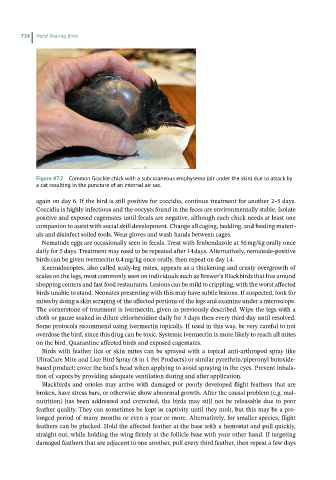Page 732 - Hand rearing birds second
P. 732
734 Hand-Rearing Birds
Figure 47.2 Common Grackle chick with a subcutaneous emphysema (air under the skin) due to attack by
a cat resulting in the puncture of an internal air sac.
again on day 6. If the bird is still positive for coccidia, continue treatment for another 2–5 days.
Coccidia is highly infectious and the oocysts found in the feces are environmentally stable. Isolate
positive and exposed cagemates until fecals are negative, although each chick needs at least one
companion to assist with social skill development. Change all caging, bedding, and feeding materi-
als and disinfect soiled tools. Wear gloves and wash hands between cages.
Nematode eggs are occasionally seen in fecals. Treat with fenbendazole at 50 mg/kg orally once
daily for 5 days. Treatment may need to be repeated after 14 days. Alternatively, nematode‐positive
birds can be given ivermectin 0.4 mg/kg once orally, then repeat on day 14.
Knemidocoptes, also called scaly‐leg mites, appears as a thickening and crusty overgrowth of
scales on the legs, most commonly seen on individuals such as Brewer’s Blackbirds that live around
shopping centers and fast food restaurants. Lesions can be mild to crippling, with the worst affected
birds unable to stand. Neonates presenting with this may have subtle lesions. If suspected, look for
mites by doing a skin scraping of the affected portions of the legs and examine under a microscope.
The cornerstone of treatment is ivermectin, given as previously described. Wipe the legs with a
cloth or gauze soaked in dilute chlorhexidine daily for 3 days then every third day until resolved.
Some protocols recommend using ivermectin topically. If used in this way, be very careful to not
overdose the bird, since this drug can be toxic. Systemic ivermectin is more likely to reach all mites
on the bird. Quarantine affected birds and exposed cagemates.
Birds with feather lice or skin mites can be sprayed with a topical anti‐arthropod spray like
UltraCare Mite and Lice Bird Spray (8 in 1 Pet Products) or similar pyrethrin/piperonyl butoxide‐
based product; cover the bird’s head when applying to avoid spraying in the eyes. Prevent inhala-
tion of vapors by providing adequate ventilation during and after application.
Blackbirds and orioles may arrive with damaged or poorly developed flight feathers that are
broken, have stress bars, or otherwise show abnormal growth. After the causal problem (e.g. mal-
nutrition) has been addressed and corrected, the birds may still not be releasable due to poor
feather quality. They can sometimes be kept in captivity until they molt, but this may be a pro-
longed period of many months or even a year or more. Alternatively, for smaller species, flight
feathers can be plucked. Hold the affected feather at the base with a hemostat and pull quickly,
straight out, while holding the wing firmly at the follicle base with your other hand. If targeting
damaged feathers that are adjacent to one another, pull every third feather, then repeat a few days

